
KNL Dragon designed by Robert Lang
This is a neat origami model that can be found in Origami Design Secrets, by Robert Lang. Origami Design Secrets is basically a textbook, so it’s here to demonstrate the “grafting” technique. Grafting can be used to create a model with one piece of paper, that might otherwise require multiple sheets of paper. This model, in its original form designed by Kunihiko Kasahara, took three pieces of paper. Robert Neale made a contribution that simplified it to two sheets of paper. Kasahara’s head design was combined with a model by Robert Neale, to make a two-piece design. Finally Robert Lang made a design that only used one sheet. It’s called the Kasahara-Neale-Lang Dragon, or KNL Dragon.
Among the many models in the book, this is a favorite. When I’ve shown this to other origami people, they often ask how to make one. You’re welcome to try this video, but it’s only recommended for experienced origamists. It involves some very tricky (and small!) sink folds–something I notice Robert Lang tends to scatter all around his designs like they’re nothing! Nonetheless, it’s a lovely model with a particularly great silhouette.

A small correction. Robert Neale’s dragon is single-sheet, and had no relation to Kasahara’s original 3-sheet design. Neale’s dragon had a very simple head—basically, just a couple of reverse folds. Back in the early days of American origami, it became popular to take the relatively ornate head of the Kasahara dragon and put it onto the Neale dragon (covering up its original simple head), and calling the result the “Kasahara-Neale dragon.” Don’t know who first did this, but it was around and about in origami circles by the mid-1980s.
@bugfolder,
Thanks for the correction!
That is very neat. I find origami fascinating. One of many crafts that I would love to try but won’t for lack of time.
Another fine model by Robert Lang. He has produced many wonderful origami models.
As an observation (certainly not a criticism) it is a mixture or advanced and somewhat anatomical realism for which Lang is so famous (albeit of a fictitious animal) grafted onto a more traditional Japanese style model that ‘suggests’ form. Perhaps the mixture is deliberate.
I read somewhere years ago that he had developed a computer program to make crease patterns of a given anatomical form such as 6 legs of a given proportion. His genius is to then take the crease pattern and figure out how to fold it into the given model. I guess it take a physicist like him to do these sorts of things.
Another fine origamist is Joseph Wu, whose original ‘flying pig’ model (https://www.origami.cz/Bin/pigwing.html) was inspiration for another winged dragon I for one adapted from it – breaking away from the original at the end of page two. It was such a simple tweak that I am almost certain others will have done it so would not dare credit myself with much.
My all time favourite though was Eric Joisel. A wonderful artist whose medium was origami. http://www.ericjoisel.fr/en/home/
Among his amazing LOTR characters and wonderful musicians is a sublime pangolin and a fascinating mermaid. The origami magic ball is a basic introduction to some techniques that he used in these two models.
Origami has been one of my favourite pastimes since I took it up, aged 7 (some 46 years ago). It is well worth the small effort to master simple models, and is an excellent meditative activity. Lots of repetition with concentration. And it is a pastime that can easily become a hobby given a little extra devotion.